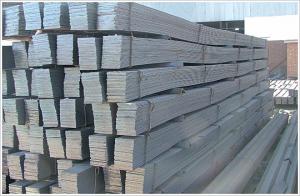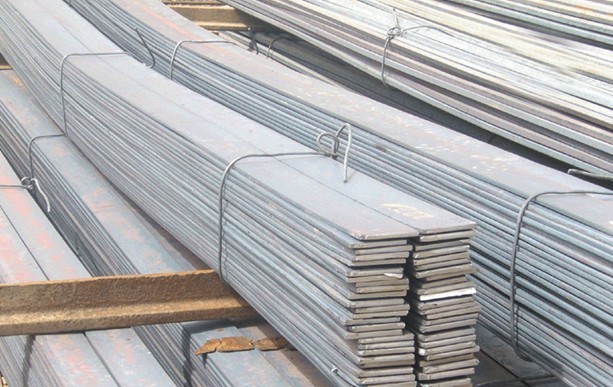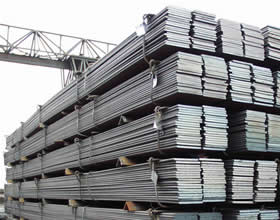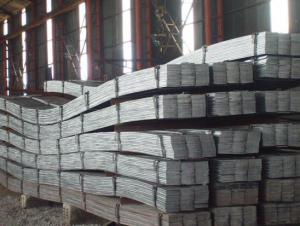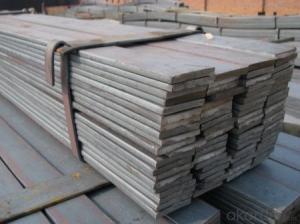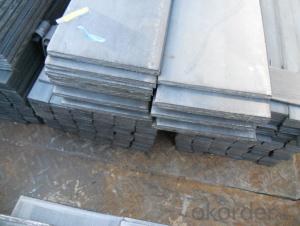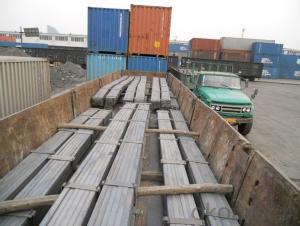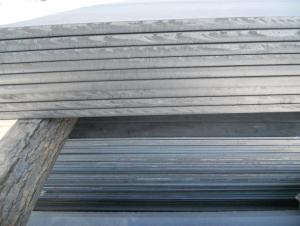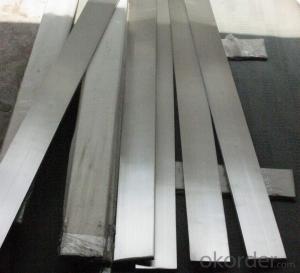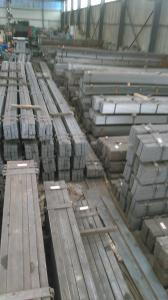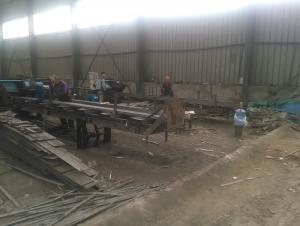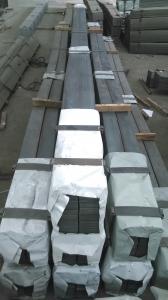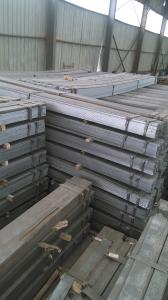Flat Steel Bar
- Loading Port:
- China Main Port
- Payment Terms:
- TT OR LC
- Min Order Qty:
- -
- Supply Capability:
- -
OKorder Service Pledge
OKorder Financial Service
You Might Also Like
Product Description:
Spring Steel can be divided into two types. One is carbon spring steel, and other one is alloy spring steel.
Alloy spring steel is based on carbon spring steel, by adding one or more alloying elements to improve the mechanical properties, hardenability and other properties to meet the requirement for manufacturing all kinds of spring steel.
Specification of Spring Steel:
-Material: 70Si2CrA
-Production: Hot rolled or cold rolled
-Standard: GB/T·5218-1999
-Type: Spring Steel
-Alloy or no: Alloy
Chemical Composition:
C | Mn | Si | Cr |
0.65~0.75 | 0.40~0.60 | 1.40~1.70 | 0.20~0.40 |
S | P | Ni | |
≤0.030 | ≤0.030 | ≤0.030 | |
Mechanical Properties:
-Annealing Condition:
1, Tensile Strength: σb/MPa:≤835
2, Elongation: δ/%:≥8
-Quencher condition:
1, Tensile strength: σb/MPa:785~1175
2, Elongation: -
Usage/Applications of Spring Steel:
For manufacturing all kinds of flat spring or round spring with small sections, clockwork spring,
Packaging & Delivery of Spring Steel:
-Packing Detail: The products can be packed in bundles by steel wires.
-Marks:
1, Tag marks: the tag marks will be tied up to each bundle of the products. The information is usually including supplier’s logo and name, product name, made in China, products’ specifications, the painted color and other information requested by customers.
2, Color marks: we will paint both ends of the bundles of these products to make sure that they are more evident. It’s will be more convenient for the customers to distinguish them at the destination port.
-Delivery Detail:
1, Delivery time: 30~45 working days after receive buyer’s T.T. or L/C.
2, Delivery status should be written in the contract. (Heat treatment or no)
Payment:
-Invoicing on theoretical weight or actual weight as customer’s request.
-FOB, CFR or CIF.
-Regular terms of payment:
1, 30% payment in advance, the remaining balance (70% payment) against the copy of B/L. 100% payment before shipment.
2, 30% payment in advance, the remaining balance (70% L/C) against the copy of B/L. 100% payment before shipment.
3, Negotiable.
- Q: Are steel flat bars suitable for making architectural elements?
- Indeed, steel flat bars are well-suited for the creation of architectural elements. Steel, being a robust and long-lasting material, can be effortlessly molded and manipulated into a variety of designs and forms. The sleek and modern appearance of steel flat bars makes them highly sought-after for architectural elements like railings, handrails, door frames, and decorative features. Architectural applications benefit greatly from the advantages offered by steel flat bars. Firstly, their high tensile strength enables them to withstand heavy loads and provide structural stability, thus making them perfect for supporting and securing architectural elements. Secondly, steel flat bars possess remarkable versatility, as they can be easily cut, bent, and welded to create intricate designs and shapes. This flexibility empowers architects and designers to fabricate unique and customized elements that perfectly match the specific requirements and aesthetic preferences of a project. Moreover, steel flat bars exhibit corrosion resistance, rendering them suitable for both indoor and outdoor applications. This durability ensures that architectural elements crafted from steel flat bars will have an extended lifespan and require minimal maintenance. Aside from their functional properties, steel flat bars also possess an aesthetic appeal. The clean lines and sleek finish of steel flat bars can elevate the overall appearance of architectural elements, infusing a modern and contemporary touch into the design of a building. All in all, steel flat bars are an appropriate choice for the creation of architectural elements, owing to their strength, versatility, durability, and aesthetic appeal. Whether utilized for structural support, decorative features, or functional elements, steel flat bars provide a reliable and visually captivating solution for a multitude of architectural projects.
- Q: Cold rolled flat steel standard. What is cold rolled flat steel?
- Flat steel, width 12-300mm, thickness 4-60mm, cross section is rectangular and with pure edge of steel. Flat steel can be finished steel, or can be used as the blank of welded pipe and thin slab for laminated sheet rolling.
- Q: Can steel flat bars be used in food processing applications?
- Indeed, steel flat bars have the capability to be utilized in food processing applications. In the food industry, steel is frequently chosen as a material due to its robustness, sturdiness, and resistance to corrosion. Specifically, stainless steel flat bars are highly suitable for food processing applications because they lack reactivity and do not release any harmful substances into the food. Moreover, stainless steel flat bars are effortless to clean and maintain, rendering them an extremely sanitary choice for food processing equipment and surfaces. Furthermore, steel flat bars can be easily manipulated and molded to satisfy the specific demands of food processing applications, thus making them an adaptable choice in this particular sector.
- Q: Are steel flat bars suitable for the construction of cultural or arts venues?
- Yes, steel flat bars can be suitable for the construction of cultural or arts venues. Steel flat bars offer strength, durability, and versatility, making them an ideal choice for structural elements such as beams, columns, and supports in these venues. Additionally, the sleek and modern appearance of steel flat bars can complement the aesthetic of cultural or arts venues, enhancing their overall design.
- Q: How do steel flat bars compare to copper flat bars?
- Steel flat bars and copper flat bars are both versatile and widely used in various industries. However, they differ significantly in terms of their properties and applications. Firstly, steel flat bars are typically stronger and more durable than copper flat bars. Steel has a higher tensile strength and hardness, making it ideal for applications that require load-bearing and structural support. It can withstand heavy loads, making it suitable for construction, manufacturing, and automotive industries. On the other hand, copper flat bars are relatively softer and more malleable, making them better suited for electrical applications, such as wiring and circuitry. Secondly, steel flat bars have excellent corrosion resistance, especially when coated with protective materials like galvanized or stainless steel. This makes them suitable for outdoor applications where exposure to moisture, chemicals, and harsh weather conditions is expected. Copper, on the other hand, is naturally corrosion-resistant and forms a protective oxide layer, making it ideal for plumbing, electrical, and marine applications. Another notable difference is their thermal conductivity. Copper is an excellent conductor of heat and electricity, making it widely used in electrical wiring and heat exchangers. Steel, although not as efficient in conducting heat and electricity as copper, still possesses moderate thermal conductivity and finds applications in heating systems and heat transfer equipment. Furthermore, steel flat bars are generally more cost-effective compared to copper flat bars. Steel is abundantly available, making it less expensive than copper, which is a relatively scarce resource. This cost difference is one of the main reasons why steel is more commonly used in construction and manufacturing industries. In summary, steel flat bars are known for their strength, durability, corrosion resistance, and cost-effectiveness. They are commonly used in load-bearing applications and outdoor environments. Copper flat bars, on the other hand, are softer, more malleable, and possess excellent electrical conductivity. They are widely used in electrical and plumbing applications. Ultimately, the choice between steel and copper flat bars depends on the specific requirements of the application at hand.
- Q: Are steel flat bars suitable for making agricultural equipment?
- Yes, steel flat bars are suitable for making agricultural equipment. Steel flat bars are known for their durability, strength, and versatility, making them an ideal material for various agricultural applications. They can be used to construct a wide range of equipment such as plows, cultivators, harrows, trailers, and livestock handling systems. Steel flat bars offer excellent structural integrity, allowing them to withstand the rigors of heavy-duty use in agricultural settings. Their high tensile strength makes them resistant to bending and breaking, ensuring long-lasting performance even under demanding conditions. Additionally, steel is highly resistant to corrosion, making it suitable for outdoor use and exposure to various weather conditions. Moreover, steel flat bars can easily be welded, cut, and shaped to meet specific design requirements, making them highly adaptable for manufacturing custom agricultural equipment. Their versatility allows for the creation of equipment that is tailored to the specific needs and preferences of farmers. In summary, steel flat bars are a reliable and suitable choice for making agricultural equipment due to their durability, strength, versatility, and resistance to corrosion.
- Q: What is the maximum temperature that steel flat bars can withstand?
- The maximum temperature endurance of steel flat bars relies on several factors, including the type of steel, its composition, and the intended usage. In general, most steel flat bars can endure temperatures ranging from 600-900 degrees Celsius (1100-1650 degrees Fahrenheit) without experiencing significant deformation or loss of structural integrity. Nevertheless, it is essential to refer to the manufacturer's specifications or engineering standards for precise information on the maximum temperature tolerance of a specific steel flat bar. Moreover, the duration of exposure to high temperatures can impact the maximum temperature endurance of steel flat bars. Sustained exposure to extreme temperatures can diminish strength and potentially lead to failure. Consequently, it is vital to consider the intended usage and adhere to industry guidelines to ensure the safe and effective utilization of steel flat bars under elevated temperatures.
- Q: How do you protect steel flat bars from chemical corrosion?
- To protect steel flat bars from chemical corrosion, there are several effective methods that can be employed. 1. Coating: Applying a protective coating is one of the most common methods to prevent chemical corrosion. There are various types of coatings available, such as paint, epoxy, enamel, or polyurethane. These coatings act as a barrier between the steel surface and the corrosive chemicals, preventing direct contact and thus reducing the risk of corrosion. It is important to choose a coating that is specifically designed for chemical resistance and to ensure proper application for maximum effectiveness. 2. Galvanization: Galvanizing steel flat bars involves applying a layer of zinc to the surface. This process creates a protective barrier that shields the steel from corrosive substances. Hot-dip galvanizing is a widely used method where the steel is immersed in molten zinc, allowing a thick and durable coating to form. Galvanized steel flat bars are highly resistant to chemical corrosion and can provide long-lasting protection. 3. Stainless steel: Using stainless steel flat bars that contain a high percentage of chromium and nickel can greatly enhance their resistance to chemical corrosion. The addition of these elements forms a passive layer on the surface that acts as a protective barrier against corrosive chemicals. Stainless steel is particularly suitable for applications where exposure to aggressive chemicals is expected. 4. Proper storage and handling: Ensuring proper storage and handling practices is essential in protecting steel flat bars from chemical corrosion. Storing them in a dry and well-ventilated area, away from corrosive substances, can help prevent direct exposure. Additionally, using protective covers or wrapping the bars in moisture-resistant materials can provide an extra layer of defense. Regular inspection and maintenance are also important to detect any signs of corrosion early. If any damage or deterioration is identified, prompt repairs or replacements should be carried out to maintain the integrity and longevity of the steel flat bars.
- Q: Are steel flat bars suitable for earthquake-prone areas?
- Yes, steel flat bars are suitable for earthquake-prone areas. Steel is a strong and durable material that can withstand seismic forces better than other materials. Flat bars provide structural stability and can be used in various applications such as reinforcing structures, bracing walls, or constructing seismic-resistant frames.
- Q: How do steel flat bars perform in terms of fire resistance?
- Steel flat bars have a high fire resistance due to their inherent non-combustible nature. They retain their structural integrity and do not contribute to the spread of fire, making them a reliable choice in fire-prone environments.
Send your message to us
Flat Steel Bar
- Loading Port:
- China Main Port
- Payment Terms:
- TT OR LC
- Min Order Qty:
- -
- Supply Capability:
- -
OKorder Service Pledge
OKorder Financial Service
Similar products
Hot products
Hot Searches
Related keywords
